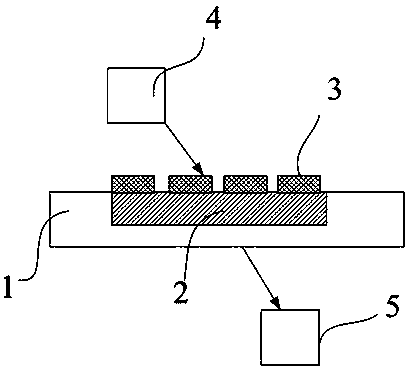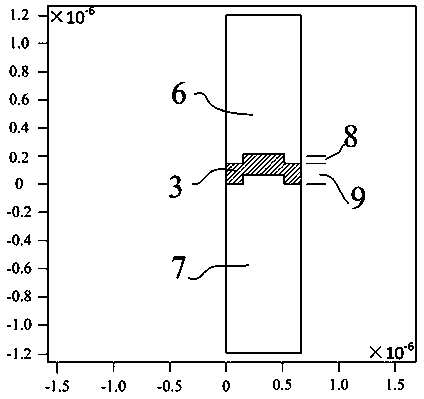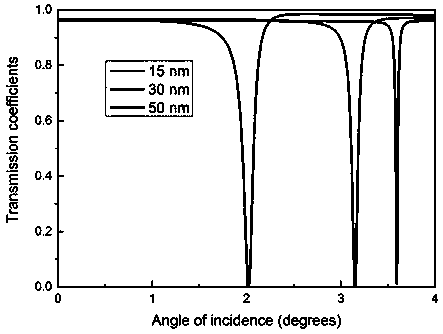An angle-dependent photonic crystal hydrogen sensor measurement method
A photonic crystal, angle-dependent technology, applied in the field of gas sensors, can solve problems such as threats to personal and property safety, fire, explosion, etc., and achieve the effect of small probe size and meet the needs of hydrogen detection
- Summary
- Abstract
- Description
- Claims
- Application Information
AI Technical Summary
Problems solved by technology
Method used
Image
Examples
Embodiment 1
[0040] Such as figure 2 To build a model, the thickness of the air layer is set to 1.2 microns, the thickness of the quartz layer is set to 1.2 microns, the thickness of the titanium dioxide layer is set to 150 nanometers, and the period is set to 400 nanometers;
[0041] The refractive index of air is set to 1, the refractive index of quartz is set to 1.46, the refractive index of titanium dioxide is set to 2.22, the incident wavelength is set to 633 nm, and the speed of light is set to 3×10 8 m / s, the ridge height is set to 15 nanometers, 30 nanometers, and 50 nanometers respectively, and the relationship between the transmission coefficient of the TM mode and the incident angle is calculated at different ridge heights;
[0042] Such as image 3 As shown in the figure, the relationship between the transmission coefficient of the TM mode and the incident angle under the condition of different ridge heights is shown in the figure. It can be seen that, other conditions remain...
Embodiment 2
[0044] Such as figure 2To build a model, the thickness of the air layer is set to 1.2 microns, the thickness of the quartz layer is set to 1.2 microns, the height of the ridge is set to 50 nanometers, and the period is set to 400 nanometers;
[0045] The refractive index of air is set to 1, the refractive index of quartz is set to 1.46, the refractive index of titanium dioxide is set to 2.22, the incident wavelength is set to 633 nm, and the speed of light is set to 3×10 8 m / s, the thickness of titanium dioxide is set to 150 nanometers, 165 nanometers, and 180 nanometers respectively, and the relationship between the transmission coefficient of the TM mode and the incident angle is calculated when the thickness of titanium dioxide is different;
[0046] Such as Figure 4 As shown in the figure, the relationship between the transmission coefficient of the TM mode and the incident angle under the condition of different titanium dioxide thicknesses is shown in the figure. It ca...
Embodiment 3
[0048] Such as figure 2 To build a model, the thickness of the air layer is set to 1.2 microns, the thickness of the quartz layer is set to 1.2 microns, the thickness of the titanium dioxide layer is set to 150 nanometers, the ridge height is set to 50 nanometers, and the period is set to 400 nanometers;
[0049] The refractive index of air is set to 1, the refractive index of quartz is set to 1.46, the refractive index of titanium dioxide is 2.22, and the speed of light is set to 3×10 8 m / s, the incident wavelength is set to 620 nm, 627 nm, and 633 nm, respectively, and the relationship between the transmission coefficient of the TM mode and the incident angle is calculated at different incident wavelengths;
[0050] Such as Figure 5 As shown in the figure, the relationship between the transmission coefficient of the TM mode and the incident angle under different incident wavelengths is shown in the figure. It can be seen that, other conditions remain unchanged, when only ...
PUM
| Property | Measurement | Unit |
|---|---|---|
| thickness | aaaaa | aaaaa |
| thickness | aaaaa | aaaaa |
| thickness | aaaaa | aaaaa |
Abstract
Description
Claims
Application Information
 Login to View More
Login to View More - R&D
- Intellectual Property
- Life Sciences
- Materials
- Tech Scout
- Unparalleled Data Quality
- Higher Quality Content
- 60% Fewer Hallucinations
Browse by: Latest US Patents, China's latest patents, Technical Efficacy Thesaurus, Application Domain, Technology Topic, Popular Technical Reports.
© 2025 PatSnap. All rights reserved.Legal|Privacy policy|Modern Slavery Act Transparency Statement|Sitemap|About US| Contact US: help@patsnap.com



